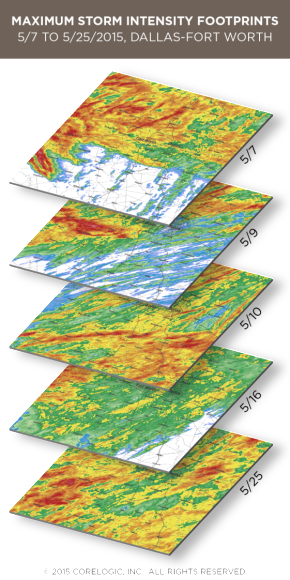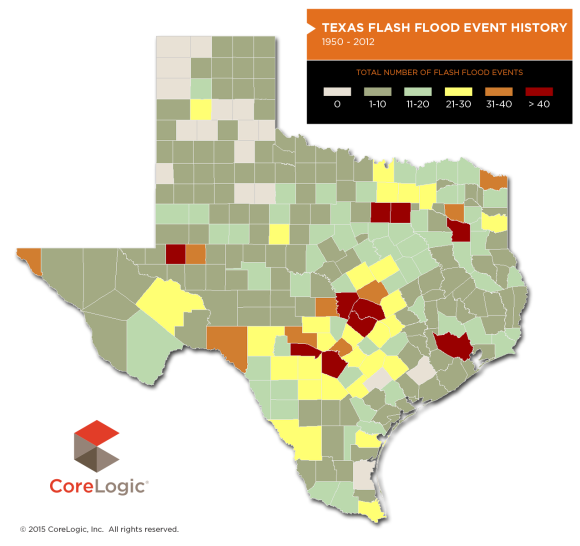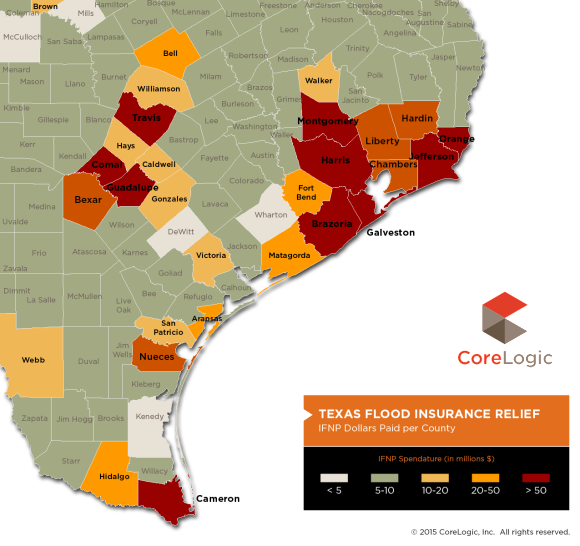This post is part of a series sponsored by CoreLogic.
Amongst Texans, nearly every conversation about weather over the last several years has focused on the ongoing drought that has resulted in water supply shortages and mandatory restrictions of water use, severe wildfire conditions, as well as a considerable reduction in recreational lake activities and what were once “waterfront properties”.

But suddenly, the problem is not a lack of water, but too much water. Record amounts of precipitation have fallen in parts of eastern and central Texas, with forecasts indicating there is more on the way.1 The result? Severe and devastating flooding that has ravaged both urban and rural homes as well as businesses, automobiles, and infrastructure.
Flooding is one of the main causes of property damage in Texas. Approximately 12% of the state’s land area is susceptible to flooding, which makes it the top state for total flood prone area.2 Weather patterns that produce severe precipitation events combined with terrain that is conducive to overland flow of water has resulted in central Texas being one of the most flash-flood prone areas in the United States.3
Unfortunately, one of the most common refrains heard during and after a severe flooding event is that some homeowners were not insured for flood damage.5
CoreLogic analyzed nearly 3,500 flood events in Texas that occurred between 1950 and 2012 and determined that 88.7% possessed a flash-flood component. Although these flood events were distributed throughout the state, it is clear that flash-flooding does not occur randomly, and in fact occurs more frequently in the central part of the state; in areas commonly referred to as Flash Flood Alley (Map 1).
One common method of evaluating flood-induced property damage is by reviewing the National Flood Insurance Program (NFIP) paid losses. In fact, according to the Federal Emergency Management Agency (FEMA):
- The National Flood Insurance Program (NFIP) paid losses for flooding in Texas from January, 1978 through March of 2015 totaling nearly $5.6 billion, which places Texas third on the list of states with NFIP payouts.4
- Geographically, the region in Texas with the worst flood losses is located along the coast, centered on Galveston and Harris counties (Map 2).
- Galveston and Harris combine to claim 68.6% of the total NFIP losses in Texas over the course of the last 37 years, based on both coastal and inland flooding.4
Inland flooding contributed significantly to the state total, with Travis, Comal, and Guadalupe counties having high flood losses.
- Texas has approximately 8 million structures located in a floodplain and nearly 3 million of those structures are not insured for flood damage.6
In 2015, the state of Texas set a new record for the amount of rainfall in the month of May—7.54 inches—with some areas receiving 10 or more inches over the span of just a couple days.1 Due to the intense precipitation and resulting flooding, more than 4,000 homes were damaged or destroyed by the raging water.7 Early estimates indicate that flood damage to insured automobiles may exceed a quarter of a billion dollars in Texas.8 When the rains cease and the waters recede, the total number of properties impacted by this flooding may be even greater. It has never been more important to be aware of the flood risk on your property and to be prepared for future flood events.
Click here for more information on mitigating Flash Flood Risk.


SOURCES:
1 Texas Sets Record Wet Month. www.weather.com, 5/29/2015.
22001 Blue Ribbon Committee Study — Texas Senate Concurrent Resolution 68.
3FloodSafety.com, 2015.
4http://bsa.nfipstat.fema.gov/reports/1040.htm, FEMA, 2015.
5Texas Flooding 2015: Without Flood Insurance, Homeowners Face Challenges In Rebuilding Homes, International Business Times, May 27, 2015.
6FEMA Statistics, 2015.
7Texas Floods 2015: Residents Start Cleanup, Struggle With Damage After Torrential Rains, International Business Times, May 27, 2015.
8Update: Texas Auto Losses From Floods Could Top $250 Million. Best’s New Service, May 28, 2015.12Strongest earthquake in 25 years for California’s Bay Area. CNN, September 2014.
Was this article valuable?
Here are more articles you may enjoy.



 The Hartford Q3 Net Income Up 41%
The Hartford Q3 Net Income Up 41%  Brown & Brown Reports Strong Q3 Revenue Growth of 35.4%
Brown & Brown Reports Strong Q3 Revenue Growth of 35.4%  Florida Appeals Court Reverses $200M Jury Verdict in Maya Kowalski Case
Florida Appeals Court Reverses $200M Jury Verdict in Maya Kowalski Case  AIG to Acquire Renewal Rights of Everest’s Retail Commercial Business Worth $2B
AIG to Acquire Renewal Rights of Everest’s Retail Commercial Business Worth $2B 

